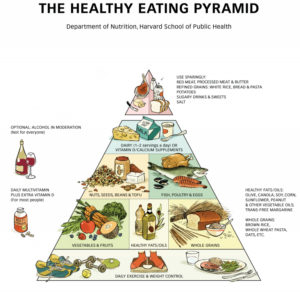The healthy eating pyramid is a nutrition guide developed by the Harvard School of Public Health, suggesting quantities of each food category that a human should eat each day. The healthy eating pyramid is intended to provide a superior eating guide than the widespread food guide pyramid created by the USDA.
The new pyramid aims to include more recent research in dietary health not present in the USDA’s 1992 guide. The original USDA pyramid has been criticized for not differentiating between refined grains and whole grains, between saturated fats and unsaturated fats, and for not placing enough emphasis on exercise and weight control. It also was developed by the Department of Agriculture, not the Department of Health and Human Services.
In general terms, the healthy eating pyramid recommends the following intake of different food groups each day, although exact amounts of calorie intake depends on sex, age, and lifestyle – Note my comments added to this in bold italics:
- At most meals, whole grain foods including oatmeal, whole-wheat bread, and brown rice; 1 piece or 4 ounces (110 g). – I would maximize more of the “ancient grains” and minimize the more processed and gluten containing grains. Also, choose organic when possible.
- Plant oils, including olive oil, canola oil, soybean oil, corn oil, and sunflower seed oil; 2 ounces (60 g) per day – I would recommend you use primarily organic olive oil (but not at high heat), canola oil (only the organic Spectrum brand -but can be used a high heat)
- Vegetables, in abundance 3 or more each day; each serving = 6 ounces (170 g).
- 2–3 servings of fruits; each serving = 1 piece of fruit or 4 ounces (110 g) – I would make your focus on berries – organic if possible – blueberries, blackberries, and raspberries. So MANY health benefits.
1–3 servings of nuts, or legumes; each serving = 2 ounces (60 g).
1–2 servings of dairy or calcium supplement; each serving = 8 ounces (230 g) non fat or 4 ounces (110 g) of whole. I would minimize dairy, being the most common food allergen/intolerance, and emphasize a calcium supplement instead. If you do eat dairy… make it from organic/free-range sources.
1–2 servings of poultry, fish, or eggs; each serving = 4 ounces (110 g) or 1 egg.
Sparing use of white rice, white bread, potatoes, pasta and sweets;
Sparing use of red meat and butter. - 1-2 glasses of red wine – I threw this in.. but it really does have a LOT of health benefits in reasonable amounts.
Wishing you a very Happy & Healthy Holiday Season – from Naturae’s Path
